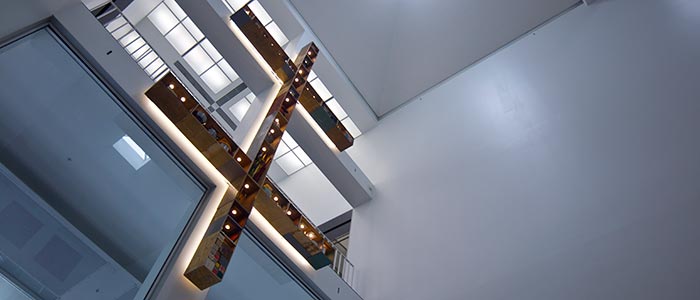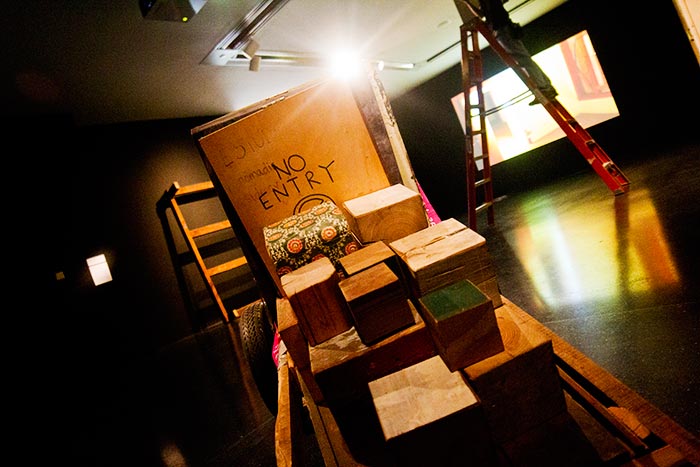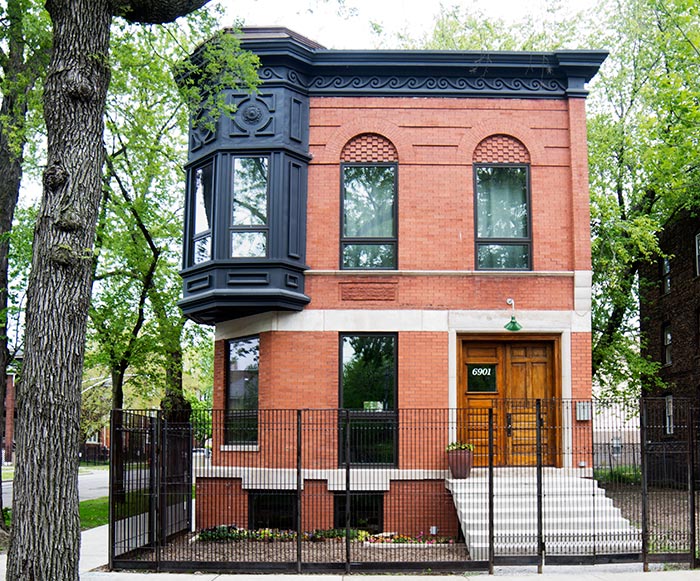Photography by Sir
Theaster Gates is going to fuck around and change the world. The idealist community has been talking about this monumental event happening for a long time now, but the changing of the world might finally actually be underway. And we have Theaster Gates and his challenging, no his redeveloping, of the status quo to thank for that. The changing of the guard has occurred, and occupying space and time from Chicago to Kassel, Germany is all it took. Go figure.

12 Ballads For Huguenot House, Gates’ exploration into creating value in forgotten-by-society places, shows us how buildings live and what they do, all the while reinventing their roles in the neighborhoods they occupy. Accomplished through creation of “temporary” economies, Gates has extended the project to juxtapose Kassel, Germany with the South Side of Chicago. A connection exists between a German past and a black present. Not to get too into the past though, because Theaster wants us to focus on the present potential of the future, but Kassel housed Henschel, a manufacturer of tanks and bombs during World War II. They relied heavily on slave labor. Huguenot House was bombed around the same time Gates’ current South Side Chicago neighborhood of Grand Crossing shifted from a predominantly Irish and German population to a 90 percent black population. Closer in cultural mindset and societal makeup than its geographical proximity of over 4000 miles would suggest, Theaster Gates has connected these two places by rebuilding through the use of ethnic labor, more specifically black labor. He has freed these two locations by working hard to restore their significance in a world that has left them to rot.
“I insist on the autonomy of architecture.” -Theaster Gates
The MCA’s current exhibition, The 13th Ballad, is a Chicagoan extension of the project that started here, migrated to Germany, and found its way back into our eagerly anticipatory embrace. You’ve heard of the tipping point. Well, if you get to the MCA for this exhibition, hell if you see any of Theaster Gates’ performances anywhere internationally, you’ll witness the tipping point firsthand. And you’ll find yourself extremely inspired. If you don’t, then there might just be something wrong with you.
The 13th Ballad is a brand new work, “an exhibition and project rich in information, concepts, and themes,” according to Michael Darling, co-organizer of the exhibition. Offering new narratives that intertwine religion and spirituality with labor practices and forced migration, the show is an “opportunity to both be reflective and implement new work,” according to the artist, activist, and epitome of avant garde himself.

Hearing Theaster use words like “migration,” “industrious,” and “accumulation” to describe the show and sum it up so succinctly, his ability to articulate the relationship between religion, labor, and migration is no simple task. Yet there’s Theaster elaborating on his themes and bringing it all together. He’s bringing the viewer to another level of consciousness, another level of understanding with every project and every word spoken, every performance, every waking of every building. Theaster Gates is changing the world by incorporating ideas we all find ourselves entangled in and/or involved with: Labor. Religion. Transformation. These ain’t no new thangs, but the ideas are even finding themselves shifted and tweaked in Theaster’s grand scheme.

Repurposed pews on the MCA’s Marjorie Blum Kovler atrium leading up to the complexity of Theaster’s double cross, whose triple and quadruple meanings are impossible to lose on anyone, greet you upon entry and immediately immerse you into the thought process behind The 13th Ballad, offering a symbolic gesture of religious tolerance while stimulating the stigmas that sometimes stifle our ability to connect with one another on a daily basis. Theaster Gates is killing that stifling noise by offering a symbolic gesture of religious tolerance.

If you’ve had the opportunity to take in a Theaster Gates performance, you know that they are as powerful as they are meaningful. They are as inspirational and intriguing as they are entertaining and insightful. They leave you with a feeling unknown anywhere else. Performances at the MCA will take place with brand new material from Theaster and his team, and that elusive feeling can be felt all through summer and into autumn. The same way street art can’t really be duplicated in a museum setting, I get the slight feeling that this exhibit might fall short of duplicating its own impact the way the actual restorations and processing of materials happened in Kassel and on Dorchester. The impact in those communities is something that can not be communicated in an exhibit of any nature. The idea can be conveyed. The performances will happen, and they will inspire on another level. But the raw, real nitty gritty of going into Kassel, going into Grand Crossing and transforming urban decay into something beautifully meaningful is where Theaster Gates’ significance sets him apart from his contemporaries. With his ambitious performances, his transformations, his reappropriation of sex and drugs, if you will, a community is born that wouldn’t have existed otherwise. It is in this magnificent creation we find importance. We find a portion of Utopia.
“Who determines who’s important in a place?” The restoration of 6901 S. Dorchester set out in 2006 to redefine what it means to live, to exist on a higher level, in a world so quick to pin types of people to a quadrant of the city. Chicago has notoriously pigeonholed types of people to types of neighborhoods, not to imply this as an exclusive practice here by any means. But having Theaster Gates firmly plant himself in the terra firma of Grand Crossing, setting up his studio and home, is an expression of connection that does not end there.

During the restoration and processing of materials from Chicago to Kassel, the undertaking became “ecumenical and spiritual.” It is in this sense of universality that we all become connected through Theaster’s work. It is here where the world is changed.
After attending the MCA’s media preview on Friday morning, we decided to take a trip over to 6901 S. Dorchester to see just how far the project has come, how the community has been affected by the work of Theaster and his team. The Dorchester House in Chicago has become an important place the same way the Huguenot House in Kassel did. Sadly, the streets are still pretty much in the ruins Theaster references. The drugs that were peddled in and around the building for the last 15-20 years are still very much prevalent, but the building is in pristine condition. It bears repeating that the most beautiful building on the block was used for 15-20 years as a means to distribute drugs. A known den of thieves, den of drug activity and denizen behavior. As a means to wake up the house, myriads of music and performance took over; to offer the house a gift.
Reflections on the idea of labor, of god, of art to transform the space and perform acts of redemption in order to transform an abandoned building in Chicago to an important one. It’s time to awaken, and the 100 days of music woke the building up from its sleep. More importantly but less immediately, Dorchester is the jumpoff for the changing of the world. And this is something only the most important man in the world can accomplish.
No pressure, though…
Theaster Gates: 13th Ballad, May 18-October 6 Museum of Contemporary Art, Chicago